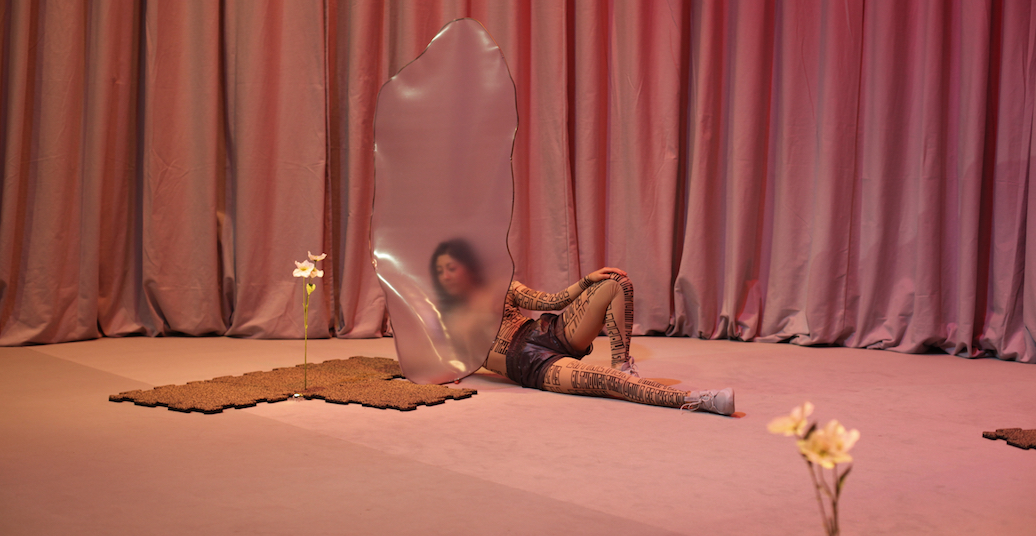Kat Válastur’s new work brings together sculpture, performance, and video to give perspective on our human experience.
This October, sound and radio artist Julia E. Dyck presented a new work at the Haus der Kulturen der Welt. In it, we listened to her and two intergallactic comrades steer a spaceship toward earth, inquiring after information on its demographics as they made their descent. The population had exploded (70 billion!), had differentiated into a plethora of species, had become genderless, had shifted to asexual reproduction, and was able to maintain their very small bodies on a leafy diet. It was a beautiful picture, utopic really, in which we were immersed. It sounded peaceful. It sounded like one of the best possible long-term solutions to our present, and looming, catastrophes. As we listened on, we discovered that not only was the human condition indeed peaceful, but that the human condition had evolved into, well, an earthworm condition. Still, doubtless, a considerably more harmonious and gentle condition than our own current one, and thus something to which we could look forward.
In Kat Válastur’s latest work, “Stellar Fauna”, similar themes of species change are visited upon the audience in two sections. Divided in half, the two parts of the performance—a live performance and a video installation—play twice; the order in which one sees the two halves ostensibly random. The half of which I am a part is led first upstairs to a separated space in the HAU 3 theatre. As an artist who always pays meticulous attention to her surrounds, Válastur had refashioned the space, so that instead of a large blackbox theatre, we were introduced to a small, light grey oval, enclosed by waving curtains and matching carpeting (perfect for the shouts of sold cloud lights which would burst in at intervals). It felt somewhere between entering a 1980’s living room, a very mysterious club, and a long un-renovated museum exhibit.
We, the audience, sat between two lobes of the stage, each symmetrically equipped with three blocks with a single white flower, a large upright rock, and an exuberantly shaped squash-like object. Most attractively, each half of the stage also possesses a shimmering, semi-translucent plate, like a cactus crossed with an iceberg, a shimmering mirage behind which lay a figure. Slowly, the figures began to move, to bend their knees, breathe out breath and sound, closing and opening their squatted legs. Something tribal; something robotic. But as, over time, the figures grew to their feet, it wasn’t just the loud juxtaposition of the technological on the primitive—but also a scampering in-between and a re-placement of these factors into a bleeping, wild, uncertain mosaic. Like fluid running up and down a spine, each figure pulsed between biological, personal, and social spheres, where ostensible technology and its markers merged in and out of time with the ostensibly organic in the tricks of their microphones, the elision of pedestrian and emoji expressions, and the fluidity and freezing of the limbs.
Throughout, they repeated a text: “We are waiting for the floods to break free although that would be the end of us.” Sometimes clearly, sometimes not, it got us: this feeling not only of helplessness in the face of things out of grasp and out of control, but that, too, sometimes we desire, or at least simply wait for, our glorious destruction. And yet, even here, we are not permitted to be fully in the throe of things, in unquestioned flow; even here Válastur makes us make decisions: where to sit, whom to watch, how to divide our attention, our gaze, our focus, our priorities, our energy. In that grey division we lose something by choosing something. We remain actors in a game, present and co-existing. We are reminded we are not obsolete until we are obsolete.
We shuffle downstairs, switching places with the other half of the audience, to the ground floor where we recline on high quality bean bags to watch one screen, our bodies passive, our faces and eyes timed together. Here, as placid beings, we watch a documentary about human beings, their features, habits, habitat. They are so like us, only slightly different. A species diverged from us some time in the past. They are so beautiful. The eyelids close so elegantly in the sun, their bodies bob so softly in the water; the shape of their mouths, their nose, their teeth differs in exquisite detail; they like to sit close to other members of their species, look closely, touch closely. Here we see a species with which we are and are not one—here we see ourselves at our future-present moment, on the edge of the unknown.




